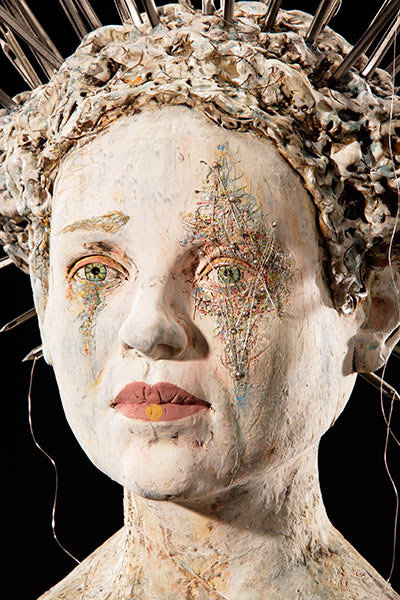Fine Art Today recently caught up with sculptor Kirsten Stingle for an in-depth inquiry the artist and her work. Her responses were attentive, complete, and sure to intrigue our readers.
Fine Art Today: Tell us a little about your creative process. What inspires you, and how do you approach an artwork from the beginning?
Kirsten Stingle: When I first started sculpting, most of my work was inspired by the found object. I would envision an old hay trolley as a post-apocalyptic creature or a lamp cage as a merry-go-round and would then create a piece with that in mind. As I grew as an artist I began to work under conceptual umbrellas and with each piece ask questions and explore different themes with regard to the concept. This conceptual umbrella became a stable construct for me to bounce within creatively. For example, one idea I return to often is the idea of self-restraint.
I ask, “Why do we hold ourselves back? Is it to provide ourselves a period of rest? Is it the beginning of a metamorphoses? Is it out of fear?” And, “How and when do we leave our restraints, and what happens if we never do?” I then transfer these inquiries and the concomitant explorations into my narratives. I never seek a definitive answer or strive to put forward an agenda, but instead take the approach of a sociologist trying to understand the world around me and my place in this world.
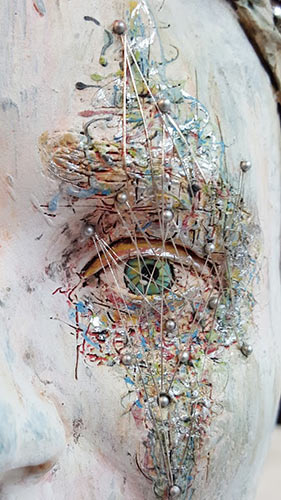
Kirsten Stingle, “Threads of Truth (detail),” porcelain, underglaze, and mixed media, (c) Allison Parssi 2016
In terms of approaching an overarching theme or concept, I usually start by creating a book of images, thoughts, writings, etc. that speak to me. Whether they are discordant or not doesn’t come into the equation. It is more a process of thinking about and researching ideas and recording all materials that speak to me in some way during that period. This process can last a while but is extremely important as it anchors my work for the collection and is something I can turn to again and again for inspiration and add to at will.
As the narratives start to develop, I then create a storyboard for each piece with images from my notebook and ideas that develop during the clay building process. This storyboard is furthered during the assembly (mixed media) process. Looking at these storyboards, I can trace how I diverged from the original ideas and the development of the narrative.
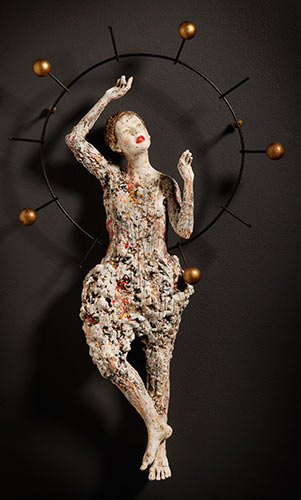
Kirsten Stingle, “Redemption,” porcelain, underglaze, and mixed media, (c) Allison Parssi 2016
What I have described may seem methodical, but that does not mean there isn’t plenty of room for spontaneity, change, and inspiration. I find this system provides me with a line of continuity between the point I start working on a piece and the time, months later, when I finish the assembly work.
Moreover, not everything I make is created in this process. There are times when I start a piece without a specific story in mind, especially before and after a big collection. Or sometimes a story hits me that I must tell but is outside the scope of the conceptual umbrella. I feel these pieces are just as valid as the other works I do. These untethered pieces prevent the work from becoming overly cerebral and allow spontaneity and inspiration to play a more active role in my work. Sometimes this play leads to later narratives and technical forms of expression.
Fine Art Today: Could you dive into the process of a specific work that will be featured in the article? Perhaps you could recall when, where, and how you were moved to create it and the process involved in its realization?
Kirsten Stingle: The following is a description of creating “The Air We Breathe.” Its evolution was the foundation for the three installations and collaboration in “Sacred and Profane.”
The initial idea “The Air We Breathe” developed fairly quickly as I was exploring universal ideas for sacred and profane. At its essence, this piece is an examination of the sacred and profane of womanhood through a female lens. We all understand that the parental role can have a lasting imprint on a child’s development and, in general, for females the mother/daughter relationship forms the foundation for who we grow to be. Absent or present, open or closed, nurturing or toxic, as women, this relationship has reverberations for the rest of our lives. I wanted to express both the nourishing and toxic possibilities of this bond. I symbolized the beneficial importance of this relationship through the umbilical cord that runs between mother and child. But this umbilical cord is actually attached to gas masks, indicating possible toxicity and suffocation or protection from the societal poisons.
However, as I started to build the piece I realized that this idea needed more than just one voice. The concept then expanded to an installation. I wanted to speak to the universality of this concept and recognize the myriad ways women experience this relationship. I was deeply influenced by Ann Hamilton’s idea of “being alone, together” and the idea of shared experiences. Therefore, I reached out to more than 20 visual and performing artists, and provided them with three-yard fabric strips. These would act as apron strings (an older symbol of the ties between mother and child). Each artist was asked to embellish the strip in any way to represent their experience of this female relationship, either as a daughter or a mother.

Kirsten Stingle, “But a Dream, Fig. 2,” porcelain, underglaze, and mixed media, (c) Allison Parssi 2016
What I did not anticipate is the transformative effect this act had on many of the artists as they worked on their pieces. Some were forced to deal with issues that they thought were put to rest, while others gained a sense of closure. Some used this as an opportunity to include their aging mothers in the process, creating mutual recognition of this bond. The process itself contributed to the intent of the piece as a whole, and provided further meaning.
During the assembly process of creating the apron, I did a lot of small embellishment including beadwork and hand-sewing. I found this process slow and tedious and was impatient with how out of pace this work was with the tempo of today. But the more time I spent on this “small work,” the more I was able to muse on the historical importance of what is seen as “women’s work.” These repetitive and contemplative tasks allowed space to think and reflect — two things in short supply in contemporary life. I wanted to recognize the drudgery and the value of this largely unrecognized work and the historical significance.
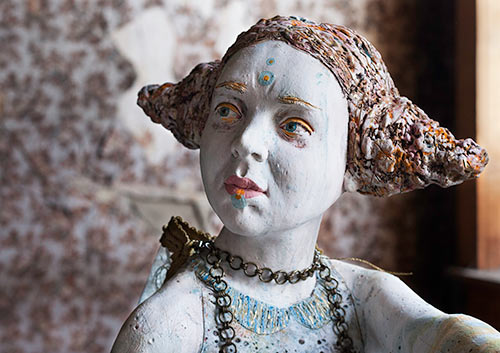
Kirsten Stingle, “But a Dream, Fig. 2 (detail),” porcelain, underglaze, and mixed media, (c) Allison Parssi 2016
Christine Kosiba took this idea a step further. Christine shared her interest in the process birds have of collecting small things to build their nests. In the installation, her ceramic ravens use the apron strings to nest. Some picking at the embellishments. It became a perfect expression of the small things that can build a life.
Fiber artist Gina Panorfi furthered the idea of small work as she created the backdrop for this piece. The delicate, often sheer, wool and silk panels suspended from the ceiling are embellished with hundreds of tiny seed beads, largely hidden from the height at which the panels hang. This backdrop provides a soft environment in which these figures dwell. Each panel represents a different stage of womanhood and the idea of what is considered sacred and profane in female development. As the stages develop, the panels become heavier, with pod-like pockets representing the physical and psychological baggage we carry through life.
I feel compelled to state that while all my work is through a female lens — because I am a woman and this is my understanding and these are my explorations — I have hesitated creating anything too “woman centered,” not only because I feel my work speaks to issues beyond a certain gender, but also, I am aware of the sometimes dismissive attitude towards these concepts. “The Air We Breathe” is in-depth look at womanhood and embodies ideas and emotional triggers that are very close to me.
Fine Art Today: You talk about connection, human experience, and narrative in your artist statement. Elaborate a little more on the ways in which your surfaces and materials reflect those ideas.
Kirsten Stingle: I feel so much of how we interact with one another is within a polite societal veneer. Through technology, we have increasing ways of communicating with one another but often don’t share and connect with others beyond the superficial. That is why narrative sculpture is so compelling to me. Stories are an entertaining way that we share thoughts and feelings. They give us a better understanding of ourselves and others, and we see the commonalities of humanity. Stories bring us together and remind us of possibilities.
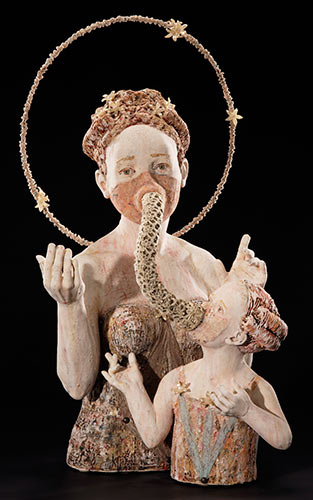
Kirsten Stingle, “The Air We Breathe,” porcelain, underglaze, and mixed media, (c) Allison Parssi 2016
Each part of my sculpture helps to tell the narrative, including the surfaces. The surfaces of my sculptures are highly texturized and layered because I am trying to show all the layers that make us who we, whether revealed on the outside or hidden beneath. Further, my figures wear pared-down body stocking-type garments reminiscent of the performing arts. Shakespeare said humans are just “petty players, strutting and fretting our hour on the stage.” I want my figures to demonstrate this aspect of the human condition. I also often blur where the clothing or costume begins and where it ends, because I use clothing as another way to reveal who the person is on the inside.
Fine Art Today: What are your primary goals, and what do you hope your audiences take away from your art?
Kirsten Stingle: With each piece I hope to create a dialogue with the viewer to examine ideas and challenge beliefs. I want my work to remind the viewer that while we are all on our own separate paths, we are on life’s journey together. I don’t say that in a Pollyanna-type way. I am not hoping for universal harmony, but rather a reprieve from isolation and misapprehension. My work is layered with light and shadow because we can’t truly understand ourselves and one another — that is, what it means to be human — if we can’t grapple with both.

Kirsten Stingle, “Voices,” porcelain, underglaze, and mixed media, (c) Allison Parssi 2016
More recently, I have been focused on trying to create surreal installations into which the viewer can escape. Rather than displaying my work as a lone piece on a pedestal, I want the viewer to feel as if they have entered a different world in which the characters, although strange, are recognizable. This has led to more collaborative work with visual and performing artists, which is very exciting. As I write this I realize I want my work to be more than a thing … I want it to be an experience.
Fine Art Today: Talk to us a little about your attraction to the figure. Why do you feel it is such a great vehicle for your artistic expression?
Kirsten Stingle: The figure is an easily relatable vehicle for storytelling. I can’t say I was very conscious of making a decision to work with the figure, but I do know that I experimented with different forms to express ideas that ultimately were inadequate and unfulfilling. I think my interest in theater naturally drew me to the human form. There is endless emotional depth and narrative expression with each gesture and pose. At this point, I gravitate toward realism because I want each work to read as a whole, and I do not want abstraction to be a distraction. Moreover, understanding and expressing the human form is a challenge that I never tire of.
Fine Art Today: Tell us more about your surfaces; they have such depth and vitality. They vibrate with life and energy. How and why is this important to your work?
Kirsten Stingle: My surfaces are an integral part of my storytelling. Each piece has up to 20-30 layers of slips, underglazes, and stains. Some of it is applied carefully and methodically, and others are applied in an energetic, gestural manner. In between the application of layers, I tear into the surface with different mark-making techniques. All of this is to indicate the complex interior layers that make up an individual. I want to create a surface that is dynamic and expresses the vivacity of life not only for conceptual reasons, but also to counterbalance the tightness of the figure. These figures are not porcelain dolls, static and perfect, but represent vibrant characters on a very human journey.
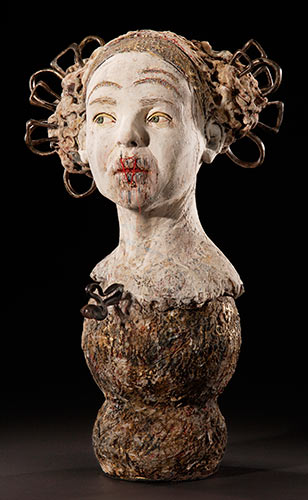
Kirsten Stingle, “Unspoken,” porcelain, underglaze, and mixed media, (c) Allison Parssi 2016
My surfaces were largely influenced by my time working in Rome, Italy. Rome is a contemporary kaleidoscopic city that wears its history like a skin. Because so much of the city is built on top of and in conjunction with earlier architecture, you can see all that the city has seen through the centuries on the streets and alleyways. In addition to these layers of history, there is contemporary graffiti, tags, and street murals. This combination of visual layers perfectly describes the character of Rome.
Fine Art Today: What has your journey to becoming a successful artist been like? Were you always interested in art?
Kirsten Stingle: My journey to become an artist has been quite circuitous. I was creative as a child and took advantage of all the things my father refused to throw away (coming from farming roots, you never throw anything away that can be repurposed or reused), building creations and worlds from the bits and bobs.

Kirsten Stingle, “Crane’s Song,” porcelain, underglaze, and mixed media, (c) Allison Parssi 2016
Looking back, one of the through lines has been storytelling. I loved the magic of the performing arts and received my BFA in Theater. While too shy to be on stage, I worked backstage in costuming and stage management. I loved working with all the different disciplines in theater to create a miraculous whole. After undergraduate, I began the first whiplash jump to receive my Masters in Public Affairs at Columbia University in New York City. Yet, even as a social welfare policy analyst, the research studies I was involved with were qualitative studies, which focused on the stories of the participants rather than reducing them to statistics. This research used the actual words of those trying to make the transition from welfare to work to point out policy gaps and inadequacies.
While this work was fulfilling in some respects, the lack of value given to improving the social welfare of those that most needed it was incredibly frustrating. I began to feel like I was not reaching anyone, and part of me yearned to be creative again. The second whiplash moment came on 9/11. Working in the city that day was a turning point for me. I began taking community classes in ceramics and never looked back.

Kirsten Stingle, “Crane’s Song (detail),” porcelain, underglaze, and mixed media, (c) Allison Parssi 2016
I often wonder what life would be like for me if I knew that I wanted to be a sculptor from a young age, and am envious of the learning time I have missed. However, as I develop as an artist, I realize I am applying the skills that I developed in the theater and as an analyst in my approach to ceramics and collaborative work.
Fine Art Today: Why ceramics and not wood, metal, or other sculptural material?
Kirsten Stingle: There is something very therapeutic about working in clay. Finding One’s Way with Clay by Paulus Berensohn had a huge impact on me when I first started in ceramics. There was a range of about 15 clays, and I spent about a year just pinching pots and noticing the different characteristics of each clay. It was such a meditative process to slowly learn the limits and timing of each clay body. Each type of clay has a personality, and you have to get to know it with your approach and temperament. When people ask me how I build without armature or work with a temperamental clay body, I always reply, “The clay and I have established an understanding. I know when to push and when to let it rest.” I feel like the clay is more of a partner or collaborator than a material.
Fine Art Today: Finally, where are Kirsten and her art in five years? How do you see your career and artwork evolving in the future, and what are some things you seek to achieve?
Kirsten Stingle: Of course I would like to continue developing my technical skills in ceramics and mixed media. I feel there is so much more room for me to grow. However, most of all, I would like to continue the type of collaborative installation work that I did with “Sacred and Profane.” I am very interested in reaching out to the public by creating a universe the viewer can explore and be inspired by.
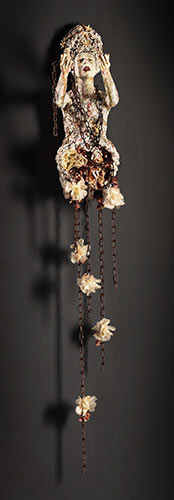
Kirsten Stingle, “Release,” porcelain, underglaze, and mixed media, (c) Allison Parssi 2016
Collaborating with other artists, both visual and performing, can be challenging because there is a certain sense of loss of control, but the process can be so much more meaningful, and the outcome more powerful, than any one voice could produce. It reminds me of my work as a stage manager, working with each artistic vision to create a unified and cohesive whole.
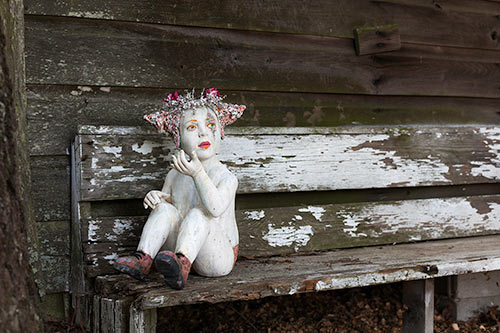
Kirsten Stingle, “But a Dream, Fig. 1” porcelain, underglaze, and mixed media, (c) Allison Parssi 2016
I would also like to work on collaborative projects that provide a level of direct community involvement. Perhaps a project that not only provides awareness about a social issue(s) but involves the identified community in its creation and/or production. I have linked some shows in the past to social justice fundraising efforts, but I would like to collaborate on an artistic level. I am currently working with another artist to create a dark fairytale installation, speaking to the isolation and challenges of children living in poverty. If this project were to come to fruition, we would like to involve the children in the creation of the actual fairytale storyboard on which the installation would be based.
—-
Stingle is overjoyed to mount a stunning exhibition, “The Sacred and Profane,” at Atlanta’s Signature Contemporary Craft on October 22. The show will run through November 26. To learn more, visit here or Kirsten Stingle.
This article was featured in Fine Art Today, a weekly e-newsletter from Fine Art Connoisseur magazine. To start receiving Fine Art Today for free, click here.

